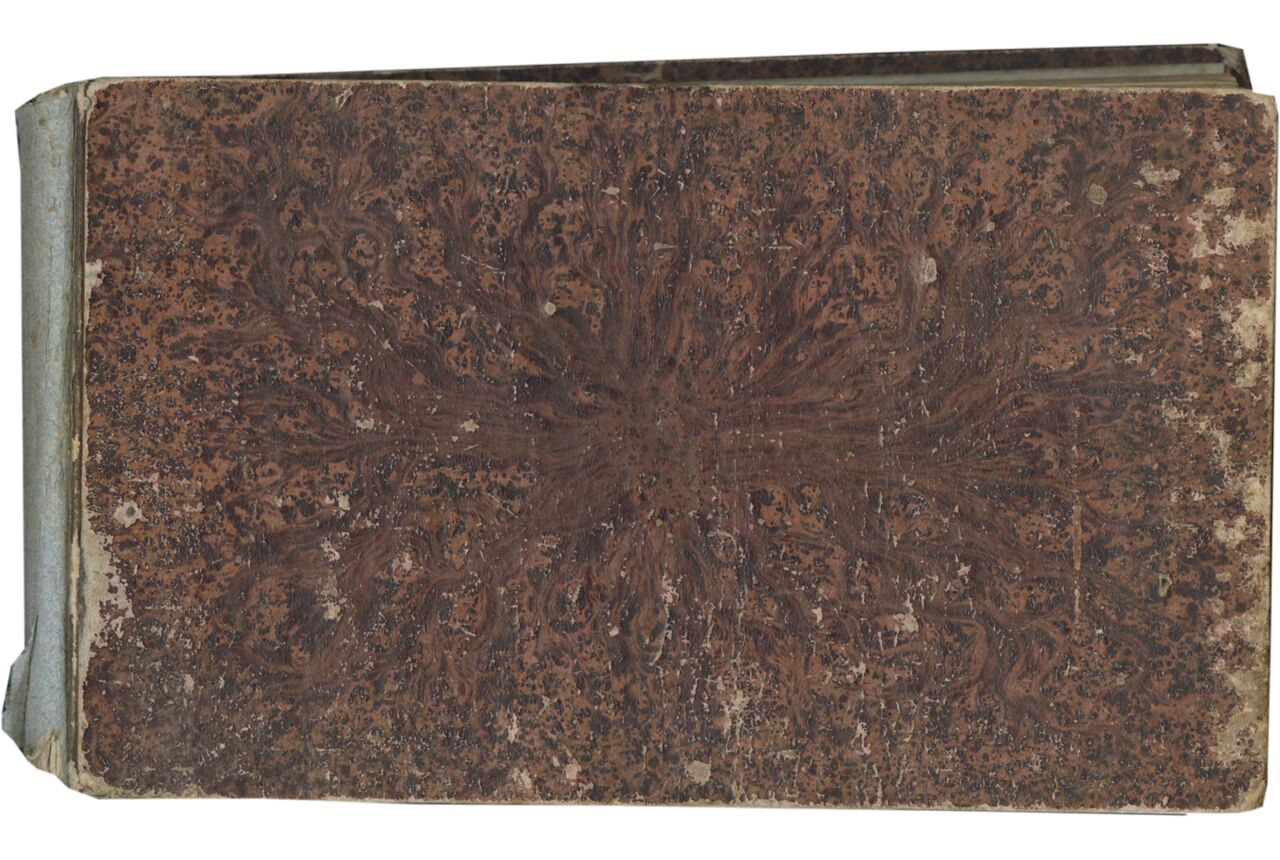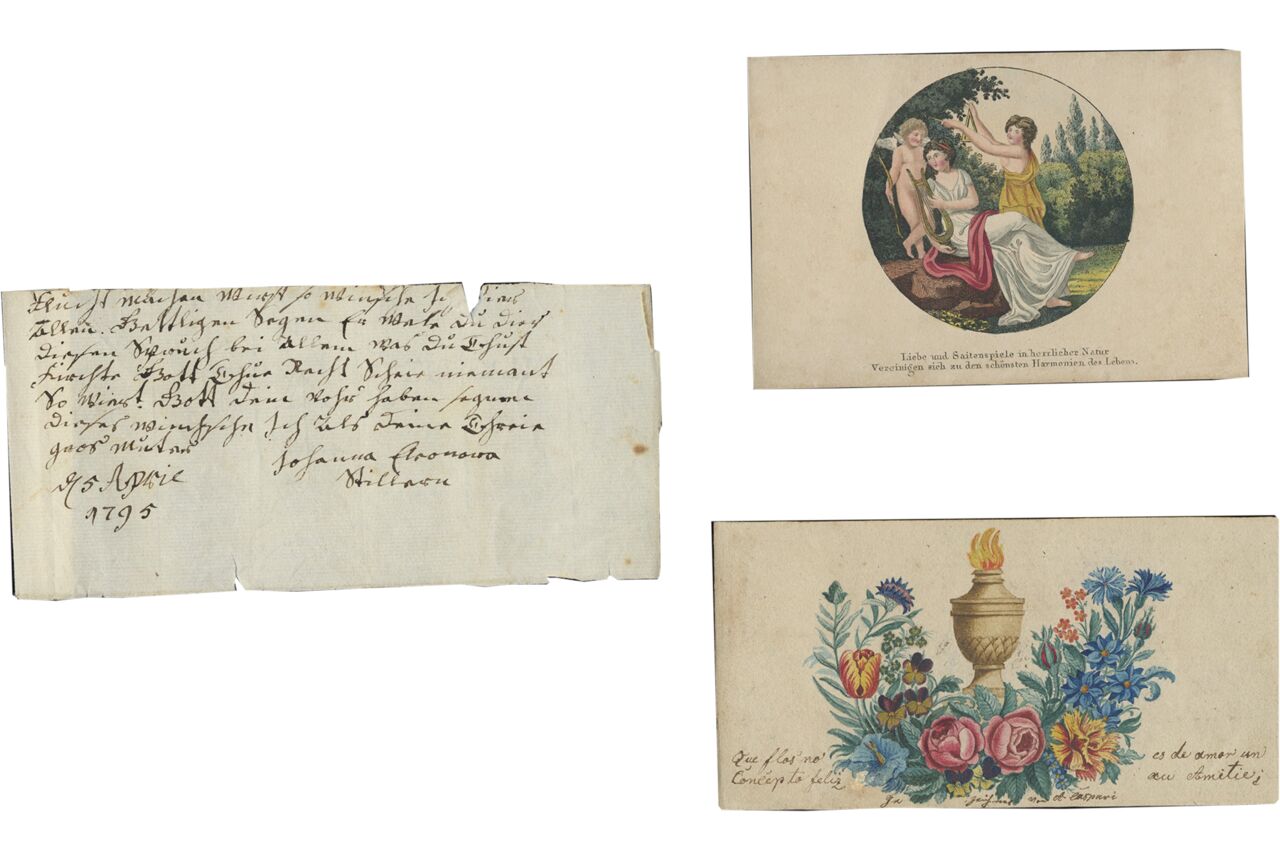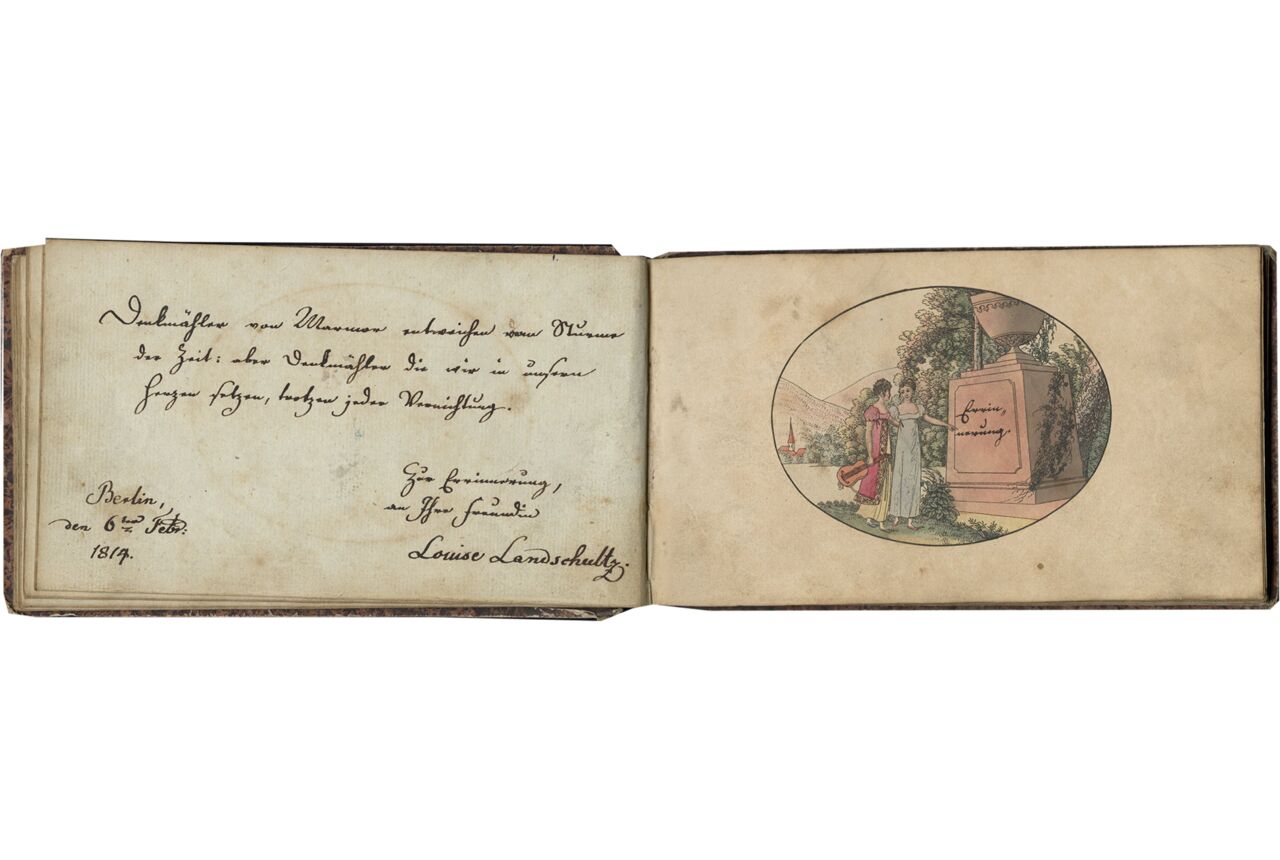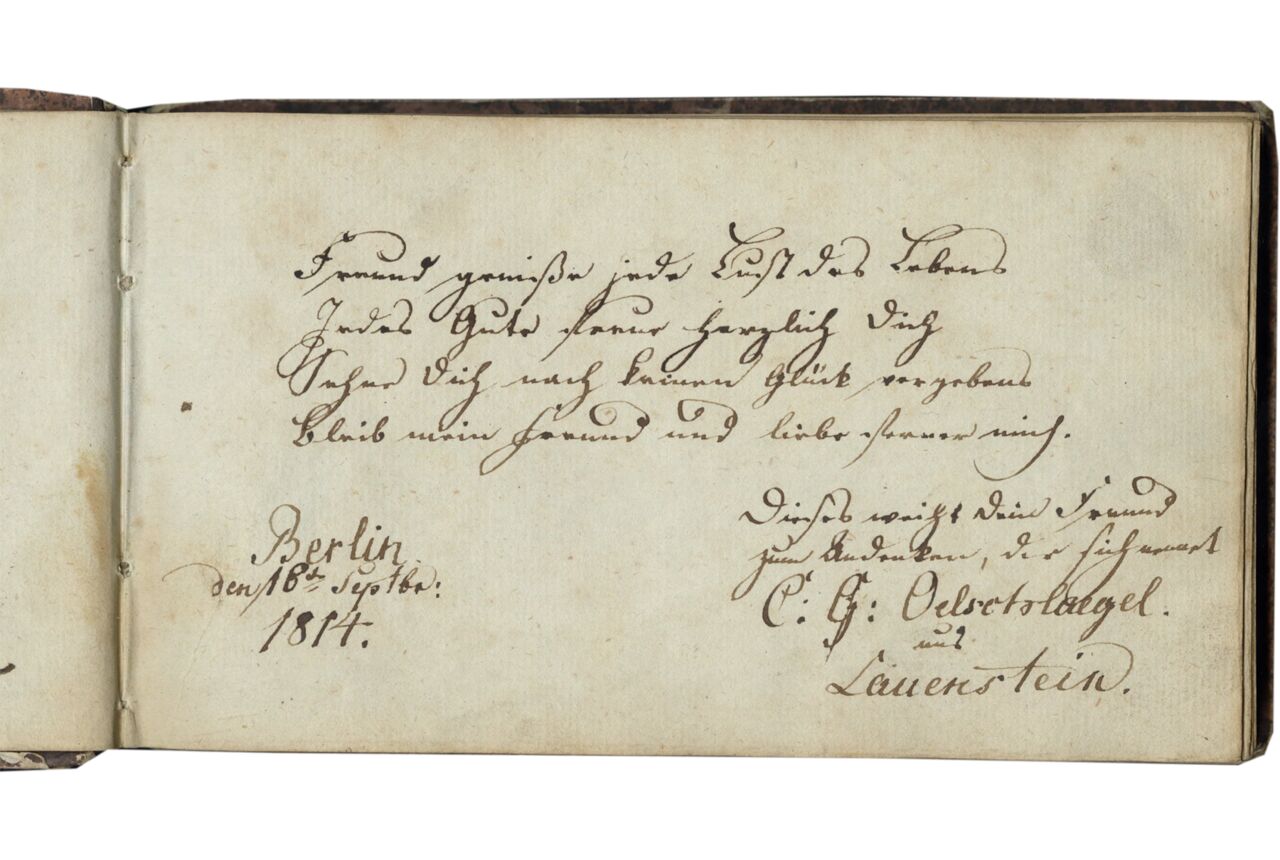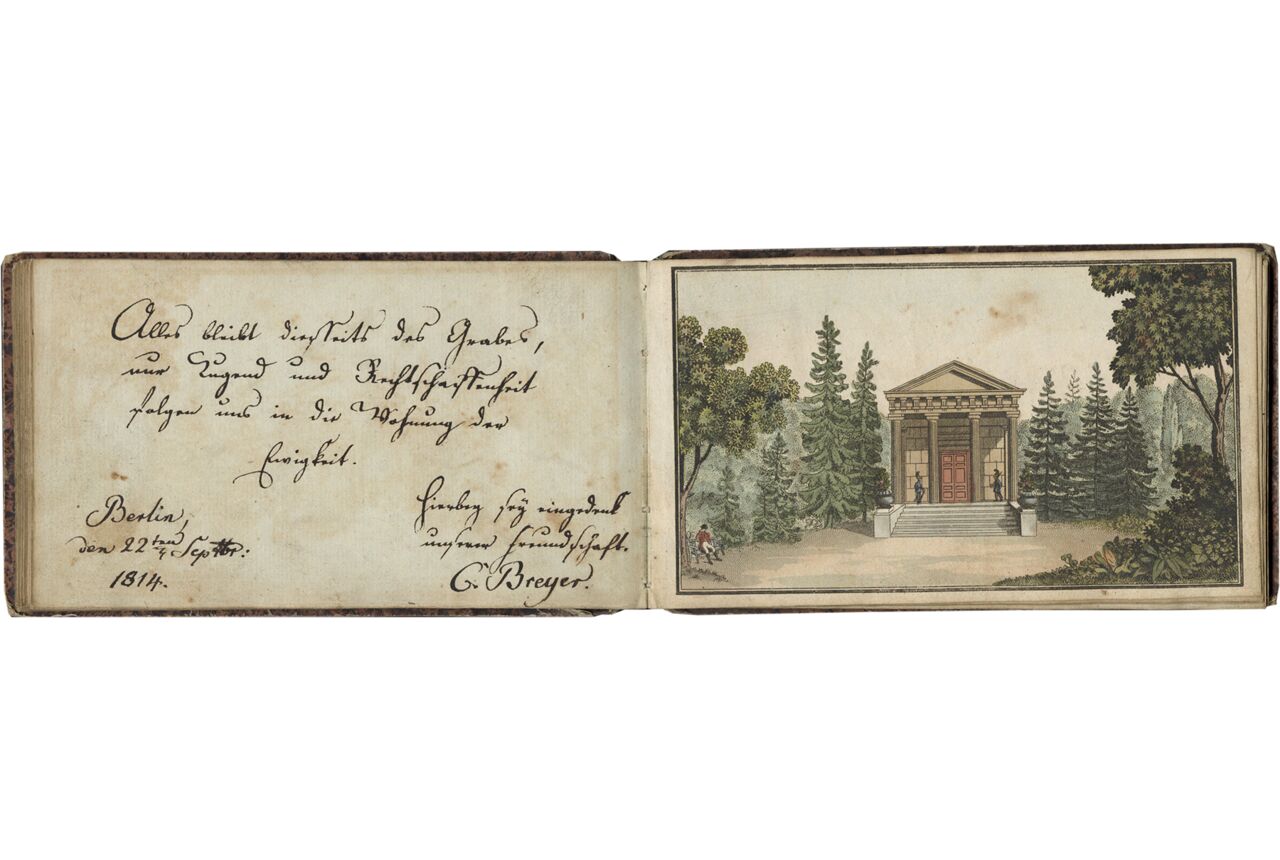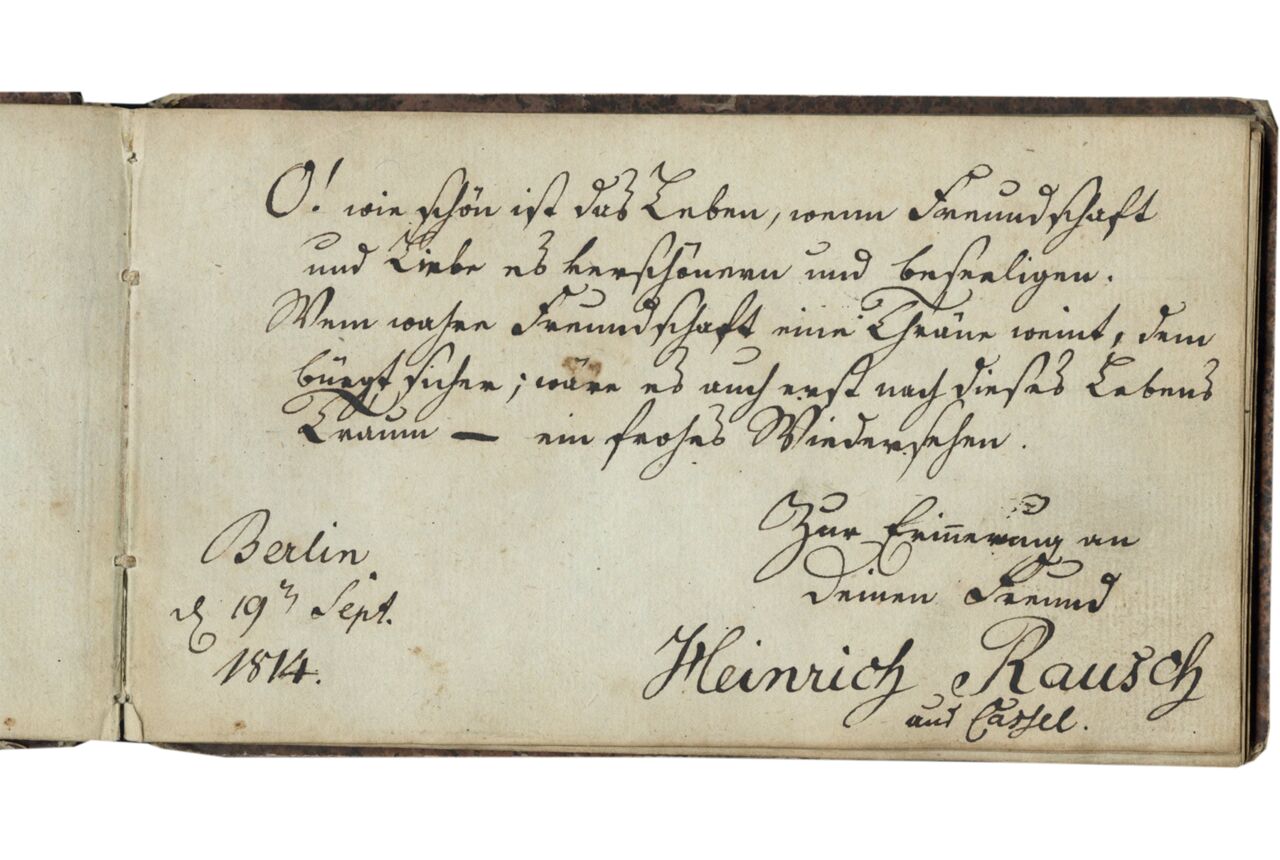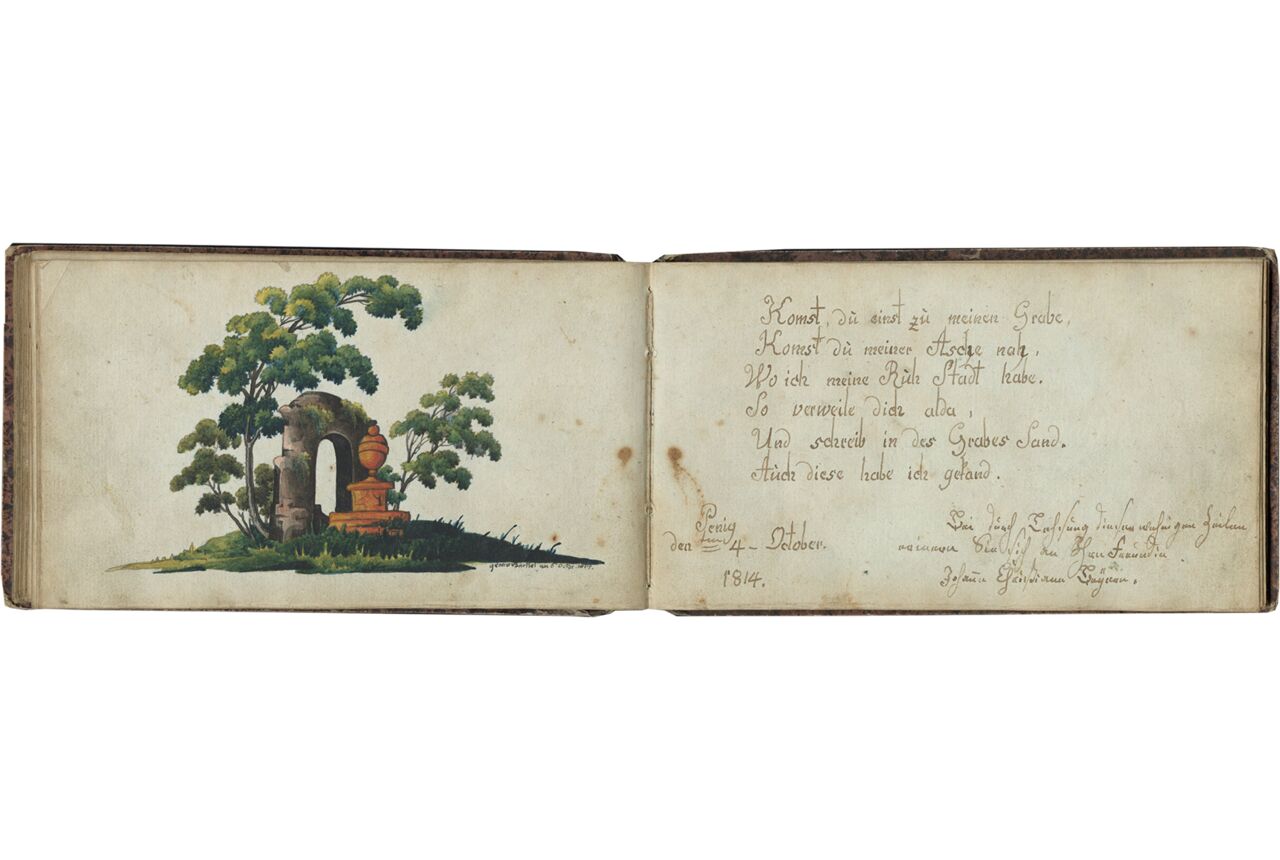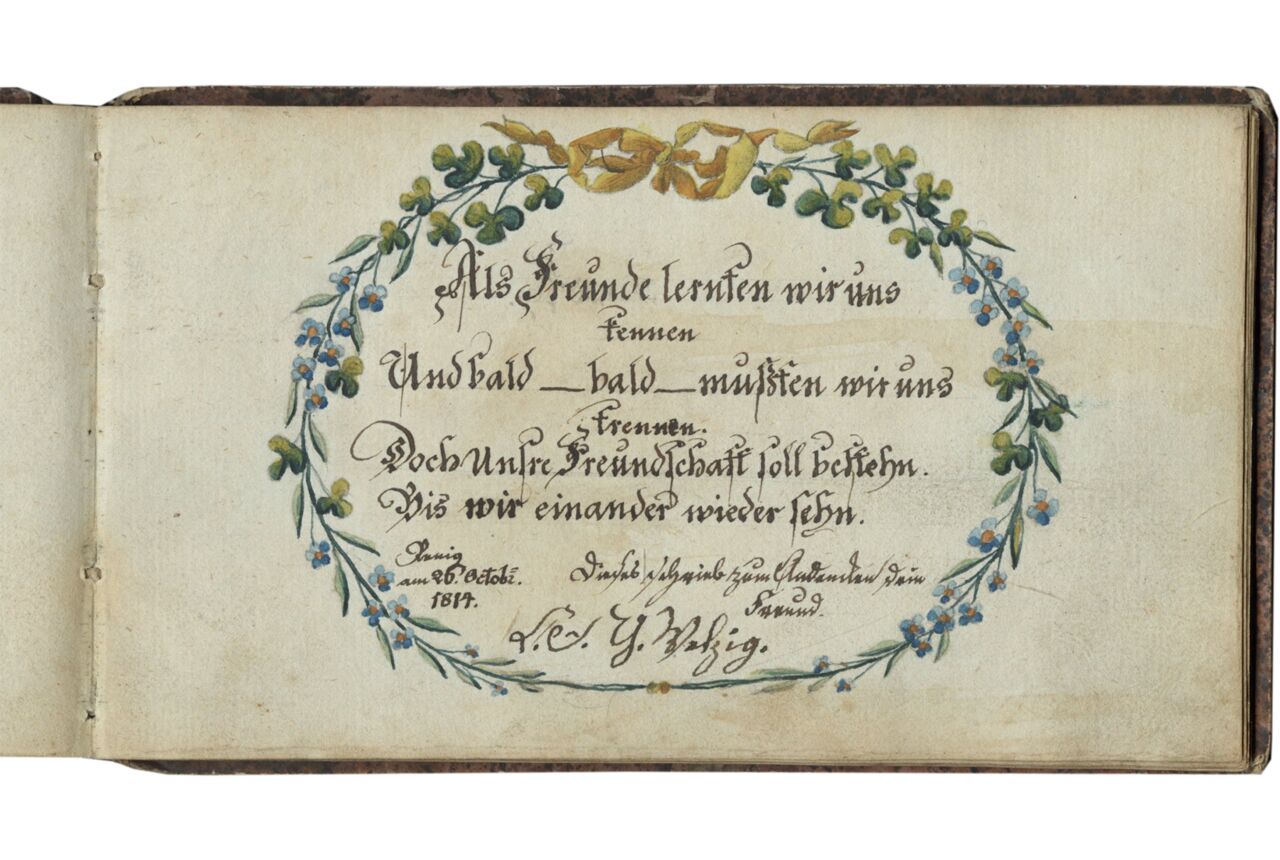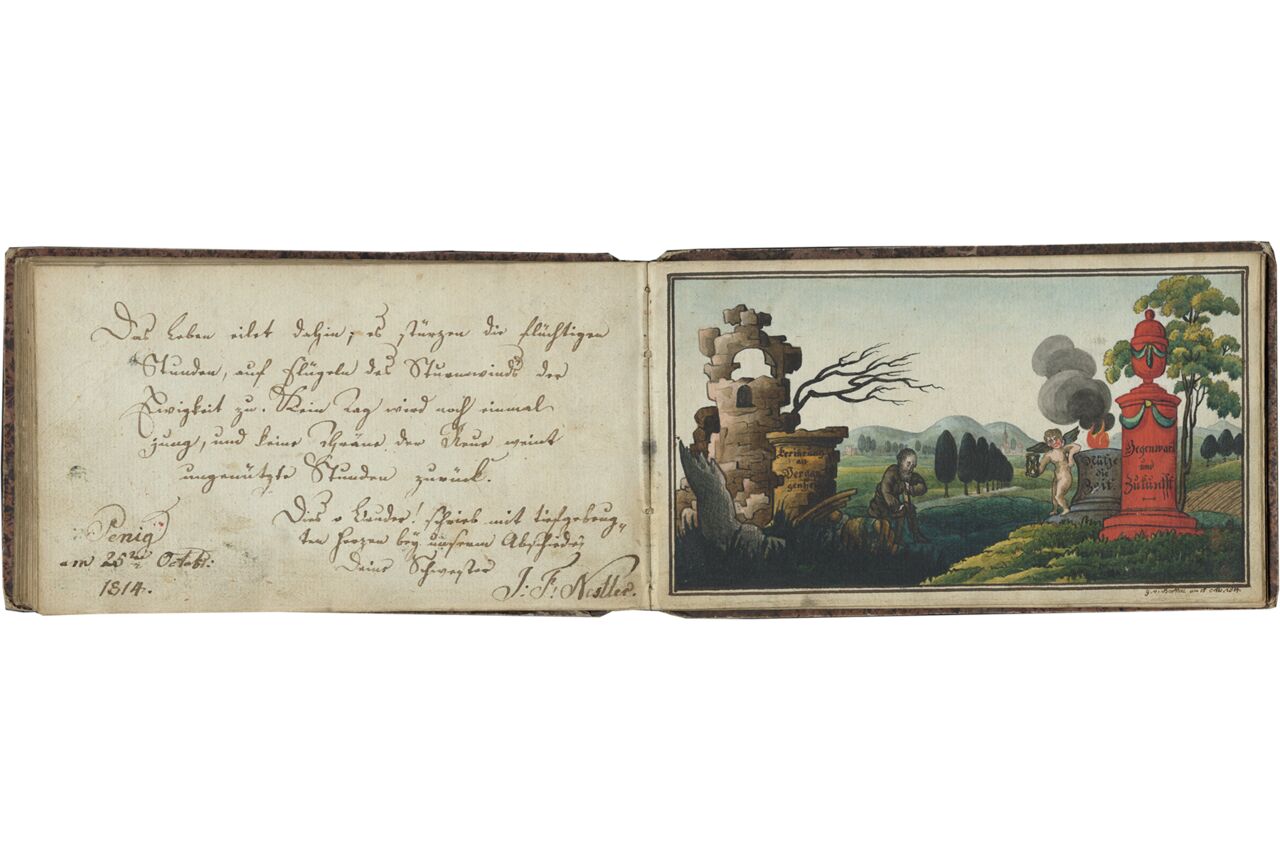85 folios on paper, watermark unidentified (a branch forming a wreath around bells?), modern foliation in pencil, 1-82, and 3 loose leaves on paper (slightly smaller in size) inserted in the book, FOUR WATERCOLORS, SIX ETCHINGS PAINTED IN WATERCOLOR, ONE SKETCH IN PENCIL, minor stains, some leaves removed and f. 35 (blank) partly lost, in overall excellent condition. ORIGINAL BINDING of marbled paper over pasteboards, gilt edges, spine cover missing, worn overall, but sewing in good condition. Dimensions 94 x 162 mm.
The most typical Album Amicorum (friendship or autograph book) was passed around at school or during the owner’s travels to his or her friends, who contributed miscellaneous poems, sayings, and drawings on the blank pages. This one is unusual. It appears to have been made to record the passing of a friend, for most of the entries refer to death or burial. It thus opens a new window into the Album Amicorum as a resource for thanatology, or the study of death and dying. Urns, mausolea, funerary monuments, birds and flowers associated with death proliferate in the visual imagery.
Provenance
1. Most of the entries in this album amicorum were made in Berlin, Penig, and Altenburg in eastern Germany in 1814. Some entries were made in Magdeburg in 1812. There are three entries made outside this period. One, dated 1806, was made by Willhelm Adler in Berlin (f. 45). In addition, there are two inserted leaves, one dated 1795 and another 1839 (made in Barmen). The identity of the person who owned this book is not revealed in the entries. However, the illustrations which are integral to the manuscript date from 1814 and refer to death and burial, suggesting that they were made to commemorate the death of a beloved friend (see the discussion below).
Overall, it seems that the album was begun by someone (unidentified), for whom Willhelm Adler offered a poem in 1806 in Berlin. The album was continued in Magdeburg in 1812. The illustrations and most text entries were made in Berlin in 1814, in the year their friend presumably died. Future research may reveal if s/he was the original owner of this album.
2. A modern bookseller’s note “104” in pencil on the front pastedown.
Text
[Two of the three unnumbered loose leaves inserted in the beginning of the book include text; first leaf], Poem in German offered by A. Caspari, and an ending note in French “Mes regrets vous suivent au tombeau”; [second leaf], Etching (described below); [third leaf], Poem in German, dated 1795 and signed Johanna Eleonora Hill... (?);
ff. 1-85v, Poems in German on ff. 4, 5, 8, 10, 16v, 19, 23, 25v, 29, 31, 32, 36, 38, 39v, 42, 44, 45, 48, 50, 54, 56, 58v, 65v, 68v, 76, 77, and 82. The other pages have illustrations or are blank, including entries by Adler, Bartsch, Breyer, Landschultz, Kramer, Oelschlaegel, Rausch, Reuter, Almich, Kempofsky, Kleinfeldt, Wunsch, and others.
Illustration
[Three unnumbered loose leaves inserted at the beginning of the book, two of which are illustrations; first leaf], Watercolor representing floral arrangement framing a stone flamepot flanked by with two lines of text in Spanish below: “Que flores no es de amor un Concepto feliz au Amitie !”, signed A. Caspari; a longer text on the verso, with the place and date: Barmen, 1839;
[second unnumbered loose leaf], Circular etching painted in watercolor representing two muses making music with a lyre and a triangle in a landscape in the company of a putto; the printed text below reads “Liebe und Saitenspiele in herrlicher Natur / Vereinigen sich zu den schönsten Harmonien de Lebens” (Love and string music in marvelous nature / Unite to create the most beautiful harmonies of life);
f. 17, Oval etching painted in watercolor representing two young ladies in a landscape, one of them points at an inscription on a mausoleum that reads “Erinnerung” (Memory), the other carries a guitar; on the facing page (f. 16v) is a poem offered by Louise Landschultz in Berlin in 1814; the etching is pasted onto f. 18;
f. 21, Sketch in pencil representing a muse leaning on a slab of stone by a tree and a small angel appearing above her; the scene was not finished and is only faintly visible;
f. 26, Etching painted in watercolor representing a Gothic funeral monument in a park; on the facing page (f. 25v) is a poem offered by Henriette Landschultz in Berlin in 1814; the etching is pasted onto f. 27;
f. 40, Etching painted in watercolor representing a classical building, a mausoleum, in a forest with two military guardians at the top of the steps; on the grounds is a gentleman seated on a bench; on the facing page (f. 39v) is a poem offered by C. Breyer in Berlin in 1814; the etching is pasted onto f. 41;
f. 47v, Watercolor representing a ruin of an arch and a red funerary urn in a landscape; on the facing page (f. 48) is a poem offered by Johann ...(?) in Penig in 1814;
f. 54, Watercolor representing a wreath of forget-me-not flowers attached with a yellow ribbon, enclosing the poem and song “Als Freunde lernten wir uns kennen...,” offered here by L.I.Y. Walzig in Penig in 1814;
f. 59, Watercolor representing an old man seated on a stone and a putto holding an hour-glass in a landscape with ruins, a large flamepot and a red funerary urn (the same as on f. 47v), signed Barthet 1814; on the facing page (f. 58v) is a poem offered by J. T. Nestler in Penig in 1814;
f. 66, Etching painted in watercolor representing two white doves kissing and joined by a flower garland atop of three large superimposed slabs of stone, below an open bird cage nestled next to a sheaf of grain; on the facing page (f. 65v) is a poem offered by Wilhelmine Landschultz in Berlin in 1814; the etching is pasted onto f. 67;
f. 69, Etching painted in watercolor representing an angel in a landscape holding lilies in one hand and palm leaves in the other, a burning flame rising from her headband, a round mausoleum in the distance, signed C. Schaner in Berlin.
Long before social media, the Album Amicorum or friendship book (album of friends), was passed around and carried about by its owner so that his or her friends and acquaintances could sign it, often adding pictures. Alba amicorum were typically compiled by young aristocrats, who collected entries from their circle of friends, professors, supporters, colleagues, relatives, and acquaintances during their travels and studies. It was mainly popular among men, but some were owned by women, who collected entries from their friends and relatives. This is an unusual example, since the imagery suggests it may have been made on the occasion of the death of a beloved friend.
The illustrations in our manuscript refer to death and burial, suggesting that they were made on the occasion of the death of a beloved friend. The illustrations of the flamepot and the red funerary urn, depicted on ff. 47v, 59, and the first inserted leaf, refer to the ancient custom of cremating the dead and placing their ashes in urns, which were then buried in fields. The name urnfield was first used over grave sites in southern Germany in the late nineteenth century. In addition, there are illustrations of a funerary mausoleum (ff. 17, 40, 69), a funeral monument (f. 26), and an angel holding the Virgin’s lilies and the martyr’s palm, both symbols of death (f. 69). Moreover, the white doves depicted on f. 66 carry strong symbolism associated with death, as they were thought to carry the souls of the dead to heaven.
The album amicorum is central in modern transdisciplinary research on texts, reception, and collecting in cultural and social contexts and the history of mentalities; see especially the comprehensive study by Werner Wilhelm Schnabel published in 2003. The albums were made from the sixteenth until the nineteenth century, and throughout their history, they usually assumed an elongated horizontal format, as is also the case for our manuscript. The rich mortuary imagery in our manuscript make it an unusual and particularly interesting volume.
Literature
Fechner, J.-U., ed. Stammbücher als kulturhistorische Quellen, Wolfenbütteler Forschungen 11, Munich, 1981.
Keil, R. and R. Die deutschen Stammbücher des sechzehnten bis neunzehnten Jahrhunderts. Ernst und Scherz, Weisheit und Schwank in Original-Mittheilungen zur deutschen Kultur-Geschichte, Berlin, 1893 (reprint Hildesheim, 1975).
Klose, W. “Stammbücher: eine kulturhistorische Betrachtung,” Bibliothek und Wissenschaft 16 (1982), pp. 41-67.
Kurras, L. Zu gutem Gedenken. Kulturhistorische Miniaturen aus Stammbüchern des Germanischen Nationalmuseums 1570-1770, Munich, 1987.
Lilienthal, M. Schediasma critico-literarium de philiothecis varioque earundum usu et abusu, vulgo von Stamm-Büchern, Königsberg, 1712; rev. Wittenberg, 1740 (repr. in Fechner, 1981, pp. 237-298). [the first study of Alba Amicorum].
Nickson, M.A.E. Early Autograph Albums in the British Museum, London, Trustees of the British Museum, 1970.
Rosenheim, M. The album amicorum, Oxford, 1910.
Schnabel, W. W. Das Stammbuch: Konstitution und Geschichte einer textsortenbezogenen Sammelform bis ins erste Drittel des 18. Jahrhunderts, Berlin, 2003.
Schünemann, H. “Stammbücher,” Schrifttumsberichte zur Genealogie und zu ihren Nachbargebieten 2 (1965), pp. 67-108.
Taegert, W. Edler Schatzholden Erinnerns: Bilder in Stammbüchern der Staatsbibliothek Bamberg aus vier Jahrhunderten, Bamberg, 1995.
Online Resources
“Repertorium Alborum Amicorum“
https://raa.gf-franken.de/de/startseite.html
TM 1244


